Human Orbital Spaceflights
![]()
International Flight No. 141STS-48Discovery (13)43rd Space Shuttle missionUSA |
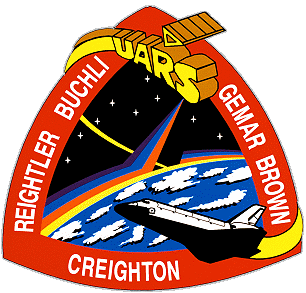 |
 |
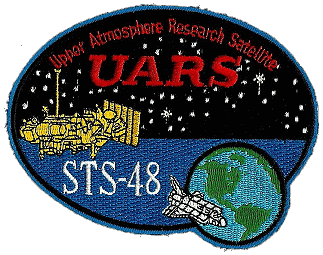 |
||
![]()
Launch, orbit and landing data
walkout photo |
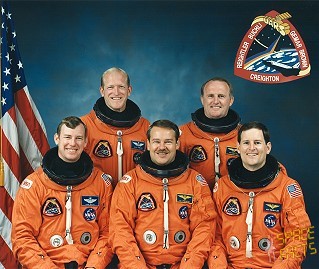 |
||||||||||||||||||||||||||||
alternative crew photo |
Crew
| No. | Surname | Given names | Position | Flight No. | Duration | Orbits | |
| 1 | Creighton | John Oliver | CDR | 3 | 5d 08h 27m 37s | 81 | |
| 2 | Reightler | Kenneth Stanley, Jr. | PLT | 1 | 5d 08h 27m 37s | 81 | |
| 3 | Gemar | Charles Donald "Sam" | MS-1, EV-2 | 2 | 5d 08h 27m 37s | 81 | |
| 4 | Buchli | James Frederick | MS-2, EV-1, FE | 4 | 5d 08h 27m 37s | 81 | |
| 5 | Brown | Mark Neil | MS-3, RMS | 2 | 5d 08h 27m 37s | 81 |
Crew seating arrangement
|
 |
|
||||||||||||||||||||||||
Hardware
| Orbiter : | OV-103 (13.) |
| SSME (1 / 2 / 3): | 2019 (9.) / 2031 (6.) / 2107 (5.) |
| SRB: | BI-046 / RSRM 18W |
| ET: | ET-42 (LWT-35) |
| OMS Pod: | Left Pod 04 (10.) / Right Pod 03 (14.) |
| FWD RCS Pod: | FRC 3 (13.) |
| RMS: | 301 (10.) |
| EMU: | EMU No. 2008 (PLSS No. 1011) / EMU No. 2013 (PLSS No. 1005) |
Flight
|
Launch from Cape Canaveral (KSC) and
landing on the Edwards
AFB, Runway 22.
The launch was delayed 14 minutes at the T-5-minute mark due to a noise problem in the air-to-ground link. The noise cleared itself, and the countdown proceeded normally to launch. The primary payload was the Upper Atmosphere Research Satellite (UARS) to study mankind's effect on the planet's atmosphere and its shielding ozone layer. The Upper Atmosphere Research Satellite (UARS) was the first major flight element of NASA's Mission to Planet Earth, a multi-year global research program that used ground-based, airborne and space-based instruments to study the Earth as a complete environmental system. Mission to Planet Earth was NASA's contribution to the U.S. Global Change Research Program, a multi-agency effort to better understand, analyze and predict the effect of human activity on the Earth's environment. Secondary objectives on the flight included Protein Crystal Growth-7, the seventh flight of a middeck experiment in growing protein crystals in weightlessness; the Middeck 0-Gravity Dynamics Experiment, a study of how fluids and structures react in weightlessness; the Investigations into Polymer Membrane Processing-4, research into creating polymer membranes, used as filters in many industrial refining processes, in space; the Physiological and Anatomical Rodent Experiment, a study of the effects of weightlessness on rodents; the Shuttle Activation Monitor, a device that will measure the amounts of gamma rays in the Shuttle's crew cabin; the Cosmic Radiation Effects and Activation Monitor, a study of cosmic radiation in the orbiter environment; the Radiation Monitoring Experiment, an often flown device that monitors the amounts of radiation inside the Shuttle; and the Air Force Maui Optical System, a use of the Shuttle's visibility in orbit to calibrate Air Force optical instruments in Hawaii. Also, in the payload bay with UARS, the Ascent Particle Monitor will measure any contaminants that enter the cargo bay during launch. UARS was designed to help scientists learn more about the fragile mixture of gases protecting Earth from the harsh environment of space. UARS provided scientists with their first complete data set on the upper atmosphere's chemistry, winds and energy inputs. One of UARS' focuses was an area in which humanity's technological advancement is changing the Earth on a global scale - depletion of ozone in the stratosphere, or upper atmosphere. The stratosphere ranges from approximately 9 to 30 miles (14.5 to 48.3 km) above the Earth's surface. Ozone, a molecule made up of three oxygen atoms, blocks ultraviolet light that can cause skin cancer and damage food crops. Although there are some natural causes of stratospheric ozone depletion, such as volcanic eruptions, the "ozone hole" that forms over Antarctica in the Southern Hemisphere's spring season and the 5 percent depletion observed over northern mid-latitudes in the last decade are a direct consequence of human activity. These long-term ozone trends are caused by chlorine compounds released into the atmosphere as by-products of industry, including refrigeration and the making of plastic foam. To study ozone depletion more completely and to better understand other aspects of Earth's fragile atmosphere, scientists need the global perspective available from an orbiting satellite, one that makes simultaneous measurements of all the factors of ozone depletion with state-of-the-art instruments. To that end, the UARS science program was designed as a single experiment with nine component instruments that studied the upper atmosphere's chemical, dynamic and energy systems. In addition to the UARS instrument science teams, 10 other teams used the data to improve theoretical models of the upper atmosphere and consequently, scientists' ability to predict the effects of change in the atmosphere. UARS had ten sensing and measuring devices: Cryogenic Limb Array Etalon Spectrometer: Like all spectrometers, the Cryogenic Limb Array Etalon Spectrometer (CLAES) searched for the telltale spectra that indicate the presence of certain chemicals. In particular, CLAES determined concentrations and distributions by altitude of nitrogen and chlorine compounds, ozone, water vapor and methane, all of which take part in the chemistry of ozone depletion. Improved Stratospheric and Mesospheric Sounder: The Improved Stratospheric and Mesospheric Sounder (ISAMS) studied atmospheric water vapor, carbon dioxide, nitrous oxide, nitric acid, ozone, methane and carbon monoxide. Like CLAES, ISAMS detected infrared radiation from the atmosphere and uses it to derive information on atmospheric temperature and composition. Microwave Limb Sounder: The Microwave Limb Sounder (MLS) provided, for the first time, a global data set on chlorine monoxide, the key intermediate compound in the ozone destruction cycle. MLS data also was used to generate three-dimensional maps of ozone distribution and to detect water vapor in the microwave spectral range. Halogen Occultation Experiment: The Halogen Occultation Experiment (HALOE) observed the vertical distribution of hydrofluoric acid, hydrochloric acid, methane, carbon dioxide, ozone, water vapor and members of the nitrogen family. Each day, HALOE observed 28 solar occultations, that is, it looked through Earth's atmosphere toward the sun to measure the energy absorption of the Sun's rays by these gases. High-Resolution Doppler Imager: By measuring the Doppler shifts of atmospheric chemicals, the High-Resolution Doppler Imager (HRDI) measured atmospheric winds between 6.2 and 28 miles (9.9 and 45 km) and above 34 miles (54.7 km). These data are important to understanding the essential role of atmospheric motion on the distribution of chemicals in the upper atmosphere. Wind Imaging Interferometer: The Wind Imaging Interferometer (WINDII) also used the Doppler shift measurement technique to develop altitude profiles of horizontal winds in the upper atmosphere. WINDII's measurements told scientists about the winds at and above 49 miles (78.9 km). Solar Ultraviolet Spectral Irradiance Monitor: Ultraviolet light from the Sun is the driver of the ozone cycle, dissociating chlorine compounds into reactive chlorine atoms that in turn break up ozone molecules. The Solar Ultraviolet Spectral Irradiance Monitor (SUSIM) measured solar ultraviolet energy, the most important spectral range in ozone chemistry. Solar Stellar Irradiance Comparison Experiment: Like SUSIM, the Solar Stellar Irradiance Comparison Experiment (SOLSTICE) conducted in-depth ultraviolet studies of the Sun. SUSIM compared the Sun's ultraviolet energy to the UV radiation of bright blue stars, providing a standard against which the solar energy level can be measured in future long-term monitoring of the Sun. Particle Environment Monitor: The Particle Environment Monitor (PEM) helped to answer questions about the effect of energetic particles from the Sun on the upper atmosphere, detecting and measuring the particles as they enter the atmosphere. PEM used four primary instrument subunits to take detailed particle measurements in different energy ranges. Active Cavity Radiometer Irradiance Monitor: The Active Cavity Radiometer Irradiance Monitor (ACRIM II) provided accurate monitoring of total solar activity for long-term climate studies. ACRIM II was an instrument of opportunity, added to the UARS spacecraft after the engineering team determined that the spacecraft could fly a 10th instrument. Though not a part of the UARS program, ACRIM II data was important to other studies within Mission to Planet Earth. The primary payload, the Upper Atmosphere Research Satellite (UARS), was deployed under the lead of Mark Brown at the controls of the RMS on the third day of the mission. During its planned 18-month mission, the 14,500-pound (6,577 kg) observatory was to make the most extensive study ever conducted of the Earth's troposphere, the upper level of the planet's envelope of life-sustaining gases which also include the protective ozone layer. UARS's initial 18-month mission was extended several times - it was finally retired after 14 years of service. The Protein Crystal Growth (PCG) payload aboard STS-48 was a continuing series of experiments leading toward major benefits in biomedical technology. The experiments on this Space Shuttle mission could improve pharmaceutical agents such as insulin for treatment of diabetes. Protein crystals like inorganic crystals such as quartz, are structured in a regular pattern. With a good crystal, roughly the size of a grain of table salt, scientists are able to study the protein's molecular architecture. Determining a protein crystal's molecular shape is an essential step in several phases of medical research. Once the three-dimensional structure of a protein is known, it may be possible to design drugs that will either block or enhance the protein's normal function within the body or other organisms. Protein crystals grown in Earth-based laboratories are typically small and lacking in uniformity or "order". However, lack of size and order greatly hamper procedures used to deduce the actual structure of the molecules constituting the protein crystal. The problem with growing larger and highly ordered crystals on Earth is analogous to trying to make a geometric shape out of Styrofoam cups on a breezy day. The "breeze" is caused by gravity-driven forces of convection that thwart attempts to arrange the cups (molecules) in a neat and orderly fashion. The growth of relatively large and highly ordered protein crystals in the almost "breeze-less" environment of space facilitates and greatly reduces the time required for the analysis of protein structure. During STS-48, 60 different protein crystal growth experiments were conducted simultaneously. Though there were four processes used to grow crystals on Earth - vapor diffusion, batch process, liquid diffusion and dialysis - only vapor diffusion will be used in this set of experiments. Shortly after achieving orbit, either Pilot Kenneth Reightler or Mission Specialist Charles Gemar combined each of the protein solutions with other solutions containing a precipitation agent to form small droplets on the ends of double-barreled syringes positioned in small chambers. Water vapor diffused from each droplet to a solution absorbed in a porous reservoir that lines each chamber. The loss of water by this vapor diffusion process produced conditions that cause protein crystals to grow in the droplets. MODE - for Middeck 0-gravity Dynamics Experiment - studied mechanical and fluid behavior of components for Space Station Freedom and other future spacecraft. Testing space structures in the normal 1g environment of Earth poses problems because gravity significantly influences their dynamic response. Also, the suspension systems needed for tests in 1g further complicate the gravity effects. Models of space structures intended for use in microgravity can be tested more realistically in the weightlessness of space. The MODE experiment consisted of special electronically-instrumented hardware that Discovery's astronauts tested in the craft's pressurized middeck section. MODE studied the sloshing of fluids in partially-filled containers and the vibration characteristics of jointed truss structures. The Cosmic Radiation Effects and Activation Monitor (CREAM) experiment was designed to collect data on cosmic ray energy loss spectra, neutron fluxes and induced radioactivity. The data were collected by active and passive monitors placed at specific locations throughout the orbiter's cabin. CREAM data were obtained from the same locations that were used to gather data for the Shuttle Activation Monitor experiment in an attempt to correlate data between the two. The active monitor was used to obtain real-time spectral data, while the passive monitors will obtain data during the entire mission to be analyzed after the flight. The flight hardware had the active cosmic ray monitor, a passive sodium iodide detector, and up to five passive detector packages. The Radiation Monitoring Equipment-III measured ionizing radiation exposure to the crew within the orbiter cabin. RME-III measured gamma ray, electron, neutron and proton radiation and calculates, in real time, exposure in RADS-tissue equivalent. The information was stored in memory modules for post-flight analysis. The hand-held instrument was stored in a middeck locker during flight except for activation and memory module replacement every 2 days. RME-III was activated by the crew as soon as possible after reaching orbit and operated throughout the mission. A crew member entered the correct mission elapsed time upon activation. RME-III was the current configuration, replacing the earlier RME-I and RME-II units. RME-III last flew on STS-31. The experiment had four zinc-air batteries and five AA batteries in each replaceable memory module. The Air Force Maui Optical Site (AMOS) tests allowed ground- based electro-optical sensors located on Mt. Haleakala, Maui, Hawaii, to collect imagery and signature data of the orbiter during cooperative overflights. The scientific observations made of the orbiter, while performing reaction control system thruster firings, water dumps or payload bay light activation, and were used to support the calibration of the AMOS sensors and the validation of spacecraft contamination models. The AMOS tests had no payload unique flight hardware and only required that the orbiter be in predefined attitude operations and lighting conditions. The Shuttle Activation Monitor (SAM) was designed to measure gamma ray data within the orbiter as a function of time and location. Located in the middeck, the crew installed a foil packet at four locations onboard. A tape recorder and two detector assemblies recorded the information. Each activation of the experiment lasted about 12 hours and recorded information from a different location of the cabin. The objective of the IPMP was to investigate the physical and chemical processes that occur during the formation of polymer membranes in microgravity such that the improved knowledge base can be applied to commercial membrane processing techniques. Supporting the overall program objective, the STS-48 mission provided additional data on the polymer precipitation process. Polymer membranes have been used by industry in separation processes for many years. Typical applications include enriching the oxygen content of air, desalination of water and kidney dialysis. Polymer membranes frequently are made using a two-step process. A sample mixture of polymer and solvents is applied to a casting surface. The first step involves the evaporation of solvents from the mixture. In the second step, the remaining sample is immersed in a fluid (typically water) bath to precipitate the membrane from the solution and complete the process. On the STS-48 mission, Commander John Creighton operated the IPMP experiment. He began by removing the units from their stowage location in a middeck locker. By turning the unit's valve to the first stop, the evaporation process was initiated. After a specified period consisting of several minutes, a quench procedure was initiated. The quench consisted of introducing a humid atmosphere which allowed the polymer membrane to precipitate out. Ground-based research indicated that the precipitation process should be complete after approximately 10 minutes, and the entire procedure is at that point effectively quenched. The two units remained stowed in the locker for the flight's duration. Electronic still photography was a new technology that enables a camera to electronically capture and digitize an image with resolution approaching film quality. The digital image was stored on removable hard disks or small optical disks, and could be converted to a format suitable for downlink transmission or enhanced using image processing software. The ability to enhance and annotate high-resolution images on orbit and downlink them in real-time was expected to greatly improve photo-documentation capabilities in Earth observations and on-board activity on the Space Shuttle as well as future long-duration flights such as Space Station Freedom or a human mission to Mars. During the STS-48 mission, NASA evaluated the on-orbit and downlinking performance and capabilities of the Electronic Still Camera (ESC), a handheld, self-contained digital camera developed by the Man-Systems Division at Johnson Space Center. The basic photographic platform was a Nikon F4 35 mm film camera converted to a digital image storing device by placement of a 1 million picture element (pixel) charge coupled device (CCD) at the film plane. The battery-operated ESC retained all the available features of the F4 and accepted any lens or optics with a Nikon mount. Lenses used on STS-48 included 20 mm AF Nikkor, 35-70 mm zoom AF Nikkor, 50 mm f/1.2 AF Nikkor and 180 mm AF Nikkor. Images obtained during the STS-48 mission were monochrome with 8 bits of digital information per pixel (256 gray levels) and stored on a removable computer hard disk. The images were viewed and enhanced on board using a modified lap-top computer before being transmitted to the ground via the orbiter digital downlinks. The PARE-01 experiment examined changes caused by exposure to microgravity in anti-gravity muscles (those used for movement) and in tissues not involved in movement. Previous experience has indicated that muscle atrophy resulting from exposure to the weightlessness of space is a serious consideration, particularly for missions of extended duration. This and similar research may ultimately lead to a better understanding of muscle wasting, which could lead to development of treatments for muscle atrophy in patients confined to bed for long periods of time, as well as for astronauts. In this experiment, eight young, healthy rats flew on the Space Shuttle. After flight, full ground studies housing an identical group of animals under identical conditions (except for the presence of gravity) were conducted. Both groups were housed in self-contained animal enclosure modules that provide food, water and environmental control throughout the flight. The Ascent Particle Monitor (APM) instruments were mounted in Atlantis' payload bay during STS-37 to measure contaminants in the bay during launch and ascent. The APM was a completely automatic system consisting of a small aluminum sample box with doors that opened immediately prior to liftoff. When the doors were opened, 12 sample collection coupons were exposed to gather particles in the environment. The doors close following ascent to protect the samples for analysis after Atlantis has landed. The APM has flown previously on several Shuttle missions and is part of an ongoing effort to better characterize the cargo bay environment during launch. The crew performed the first Collision Avoidance Maneuver (COLA) to fly in save distance to a Kosmos 955 satellite segment, which had already been launched on September 20, 1977. Due to weather conditions at Cape Canaveral (KSC) in Florida, Discovery flew one extra orbit and was then diverted to the Edwards Air Force Base, California. |
Photos / Graphics
 |
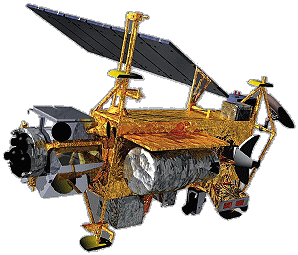 |
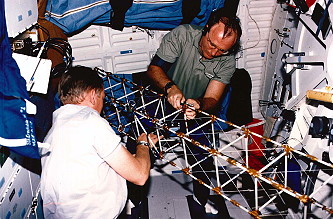 |
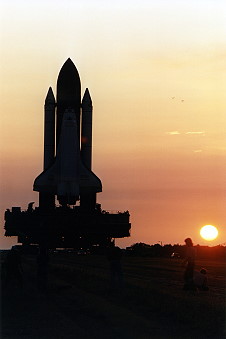 |
 |
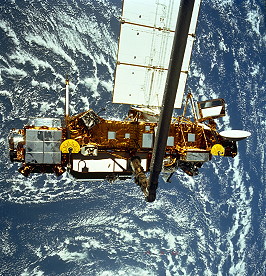 |
 |
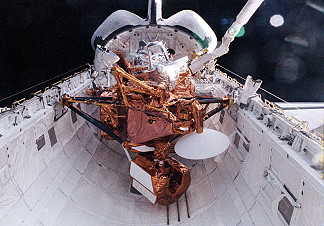 |
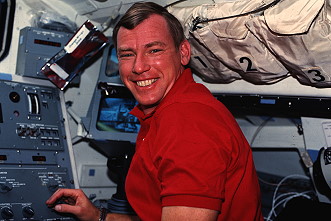 |
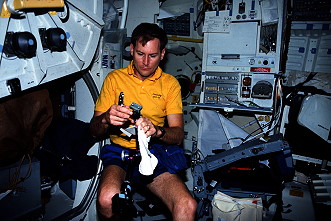 |
 |
|
Earth observation photos |
|
| © |  |
Last update on June 23, 2023.  |
 |